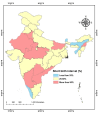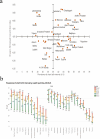Wealth-based disparities in the prevalence of short birth interval in India: insights from NFHS-5
- PMID: 38992717
- PMCID: PMC11238510
- DOI: 10.1186/s12963-024-00334-0
Wealth-based disparities in the prevalence of short birth interval in India: insights from NFHS-5
Abstract
Background: Short birth interval (SBI) has profound implications for the health of both mothers and children, yet there remains a notable dearth of studies addressing wealth-based inequality in SBI and its associated factors in India. This study aims to address this gap by investigating wealth-based disparities in SBI and identifying the underlying factors associated with SBI in India.
Methods: We used information on 109,439 women of reproductive age (15-49 years) from the fifth round of the National Family Health Survey (2019-21). We assessed wealth-based inequality in SBI for India and its states using the Erreygers Normalised Concentration Index (ECI). Additionally, we used a multilevel binary logistic regression to assess the factors associated with SBI in India.
Results: In India, the prevalence of SBI was 47.8% [95% CI: 47.4, 48.3] during 2019-21, with significant variation across states. Bihar reported the highest prevalence of SBI at 61.2%, while Sikkim the lowest at 18.1%. SBI prevalence was higher among poorer mothers compared to richer ones (Richest: 33.8% vs. Poorest: 52.9%). This wealth-based inequality was visible in the ECI as well (ECI= -0.13, p < 0.001). However, ECI varied considerably across the states. Gujarat, Punjab, and Manipur exhibited the highest levels of wealth-based inequality (ECI= -0.28, p < 0.001), whereas Kerala showed minimal wealth-based inequality (ECI= -0.01, p = 0.643). Multilevel logistic regression analysis identified several factors associated with SBI. Mothers aged 15-24 (OR: 12.01, p < 0.001) and 25-34 (2.92, < 0.001) were more likely to experience SBI. Women who married after age 25 (3.17, < 0.001) and those belonging to Scheduled Caste (1.18, < 0.001), Scheduled Tribes (1.14, < 0.001), and Other Backward Classes (1.12, < 0.001) also had higher odds of SBI. Additionally, the odds of SBI were higher among mothers in the poorest (1.97, < 0.001), poorer (1.73, < 0.001), middle (1.62, < 0.001), and richer (1.39, < 0.001) quintiles compared to the richest quintile. Women whose last child had passed away were also significantly more likely to have SBI (2.35, < 0.001). Furthermore, mothers from communities with lower average schooling levels (1.18, < 0.001) were more likely to have SBI. Geographically, mothers from eastern (0.67, < 0.001) and northeastern (0.44, < 0.001) regions of India were less likely to have SBI.
Conclusion: The significant wealth-based inequality in SBI in India highlights the need for targeted interventions focusing on economically disadvantaged women, particularly in states with high SBI prevalence. Special attention should be given to younger mothers and those from socially disadvantaged groups to enhance maternal and child health outcomes across the country.
Keywords: Erreygers normalized concentration index; India; NFHS-5; Short birth interval; Wealth-based inequality.
© 2024. The Author(s).
Conflict of interest statement
The authors declare no competing interests.
Figures




Similar articles
-
Wealth-based inequality in underweight among Scheduled Tribe women in India: a regional analysis.Int J Equity Health. 2025 Jan 23;24(1):27. doi: 10.1186/s12939-025-02392-8. Int J Equity Health. 2025. PMID: 39849479 Free PMC article.
-
Spatiotemporal change in socioeconomic inequality in hygienic menstrual product use among adolescent girls in India during 2015-2019.Int J Equity Health. 2023 Sep 29;22(1):202. doi: 10.1186/s12939-023-02020-3. Int J Equity Health. 2023. PMID: 37773141 Free PMC article.
-
Short birth interval and associated factors in rural India: A cross-sectional study.J Biosoc Sci. 2023 Jul;55(4):735-754. doi: 10.1017/S0021932022000256. Epub 2022 Jul 5. J Biosoc Sci. 2023. PMID: 35787302
-
Poverty induced inequality in nutrition among children born during 2010-2021 in India.PLoS One. 2024 Nov 14;19(11):e0313596. doi: 10.1371/journal.pone.0313596. eCollection 2024. PLoS One. 2024. PMID: 39541291 Free PMC article.
-
Factors explaining regional variation in under-five mortality in India: An evidence from NFHS-4.Health Place. 2020 Jul;64:102363. doi: 10.1016/j.healthplace.2020.102363. Epub 2020 Jun 26. Health Place. 2020. PMID: 32838888 Review.
References
-
- Cicely M. Report of a WHO Technical consultation on birth spacing. World Health Organization. Geneva; 2005.
-
- RamaRao S, Townsend J, Askew I. Correlates of inter-birth intervals and implications of optimal birth spacing strategies in Mozambique. Popul Counc. 2006;40(3):1–19.
-
- Das T, Roy TB. While inadequate birth interval becomes detrimental to health & nutritional outcome in infant and under-five year children; a systematic review through BLR and CPH model. Clin Epidemiol Glob Heal [Internet]. 2021;11(February):100714. 10.1016/j.cegh.2021.100714.
MeSH terms
LinkOut - more resources
Full Text Sources
Miscellaneous

